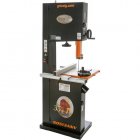So I have a 20 yr old 10" bench top bandsaw. The motors finally getting weak, I just replaced the capacitor a while back and the 1/3hp motor just doesn't seem strong enough to cut some bone. It actually slowed my blade down enough that it broke my blade. So I'm thinking it's time to upgrade. As the 10" only has about a 4" height cut, I was looking at a 14" bandsaw. Looking at the Grizzly's btw. The Jets are a little too high for me. Now the grizzly has a 14" extreme that has a 1 1/2hp motor. Of course the cutting height is still only a little above 6". I can buy an extension kit to take it to a 12" and that kit costs about $100. I can get a grizzly 17", which has the 12" cutting hieght for $70 more which is cheaper than the extension kit. But I'm wondering if the 17" is just overkill. I do like the idea of a 12" cut on the 17" saw as wanting to get more into turning larger bowls one day, it will cut bigger logs. But I'm not at that point right now. So I come to the minds of the professionals here for your opinions. Would you get one that will take care of my future needs now, or just wait to see if I progress and get the smaller one and just upgrade later?
Just food for thought, I looked at a couple reviews for the harbor freight and northern bandsaws and the reviews are not the best. So I've decided to just spend a little more to get better quality. Looking forward to your opinions.
I was looking at 2 Grizzly's. They have the G0555X which is 14" and a 1 1/2hp motor, Table is 20 1/2" x 14". It's $855. But the 17" has a 2hp motor for $70 more. The table is 17" x 17". Its the G0513anv.
https://www.grizzly.com/products/Grizzly-14-Extreme-Series-Bandsaw/G0555X
https://www.grizzly.com/products/Grizzly-17-2-HP-Bandsaw-Anniversary-Edition/G0513ANV
Just food for thought, I looked at a couple reviews for the harbor freight and northern bandsaws and the reviews are not the best. So I've decided to just spend a little more to get better quality. Looking forward to your opinions.
I was looking at 2 Grizzly's. They have the G0555X which is 14" and a 1 1/2hp motor, Table is 20 1/2" x 14". It's $855. But the 17" has a 2hp motor for $70 more. The table is 17" x 17". Its the G0513anv.
https://www.grizzly.com/products/Grizzly-14-Extreme-Series-Bandsaw/G0555X
https://www.grizzly.com/products/Grizzly-17-2-HP-Bandsaw-Anniversary-Edition/G0513ANV


